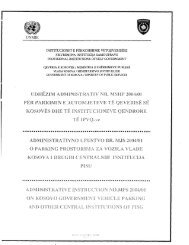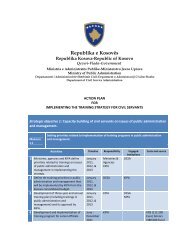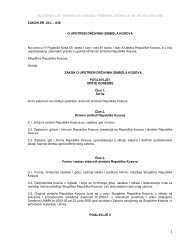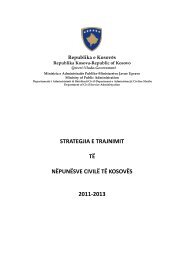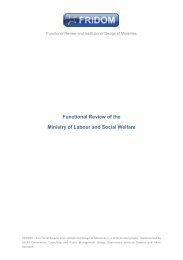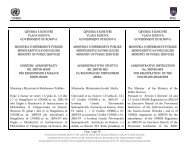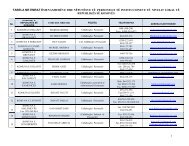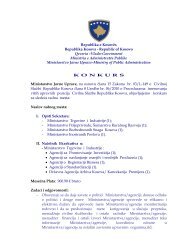Functional Review of the Ministry of Education, Science and ...
Functional Review of the Ministry of Education, Science and ...
Functional Review of the Ministry of Education, Science and ...
You also want an ePaper? Increase the reach of your titles
YUMPU automatically turns print PDFs into web optimized ePapers that Google loves.
Annex 2: FRIDOM’s comments on <strong>the</strong> new organogram designed by <strong>the</strong> MEST<br />
The FRIDOM’s comments on <strong>the</strong> new organogram based on its scheme provided with <strong>the</strong> MEST´s<br />
remarks on <strong>the</strong> Draft Report are as follows:<br />
1. The new organogram contains 3 groups <strong>of</strong> related units with three director generals (DGs) as<br />
coordinators. Two <strong>of</strong> <strong>the</strong> groups are similar to those proposed by <strong>the</strong> report. They are <strong>the</strong> Preuniversity<br />
education group <strong>and</strong> <strong>the</strong> Higher education <strong>and</strong> R&D group. The third group –<br />
Administration group with <strong>the</strong> corresponding DG – was originally considered also by FRIDOM’s<br />
team but in <strong>the</strong> end it was replaced, in accordance with common FRIDOM’s approach, by<br />
Administration department <strong>and</strong> <strong>the</strong> DG for administration was omitted.<br />
2. The departments <strong>of</strong> <strong>the</strong> Pre-university education group in <strong>the</strong> new organogram partly differ from<br />
those proposed by <strong>the</strong> Report. The organogram keeps <strong>the</strong> two existing pre-university education<br />
departments (for administration <strong>and</strong> for development) <strong>and</strong> adds a new department for VET. As <strong>the</strong><br />
report stresses, <strong>the</strong>re are two basic approaches for organization <strong>of</strong> ministry in <strong>the</strong> area <strong>of</strong> preuniversity<br />
education:<br />
a. according to type <strong>of</strong> schools (primary / general secondary / vocational / special),<br />
b. according to type <strong>of</strong> activities (administration / development / quality assurance /<br />
st<strong>and</strong>ardization <strong>and</strong> testing).<br />
The report proposed <strong>the</strong> use <strong>of</strong> “type-<strong>of</strong>-school” approach at <strong>the</strong> departmental level taking into<br />
account that <strong>the</strong> MEST preferred to have a new department for VET. The new organogram<br />
adopted a mixed approach having two departments defined according type <strong>of</strong> activities <strong>and</strong> <strong>the</strong><br />
third based on type <strong>of</strong> school approach. This organization seems to be less transparent than that<br />
proposed by <strong>the</strong> report.<br />
3. The Higher education <strong>and</strong> R&D group in <strong>the</strong> new organogram is at <strong>the</strong> MEST level identical with<br />
<strong>the</strong> report’s proposal. But <strong>the</strong> organogram proposes 3 new agencies: Center for International<br />
Cooperation in HE & <strong>Science</strong> <strong>and</strong> Technology, Centre <strong>of</strong> Innovation & Transfer <strong>of</strong> Technology <strong>and</strong><br />
National Academic Recognition & Information Center. The report prefers to make organizational<br />
changes (including eventual introduction <strong>of</strong> fur<strong>the</strong>r agencies) in <strong>the</strong> R&D area after elaboration <strong>of</strong><br />
a strategy in this area only.<br />
4. The biggest differences between <strong>the</strong> new organogram <strong>and</strong> <strong>the</strong> report concern <strong>the</strong> support area.<br />
The new organogram does not consider having an Administration department <strong>and</strong> keeps some <strong>of</strong><br />
<strong>the</strong> divisions <strong>of</strong> <strong>the</strong> Administration department proposed by <strong>the</strong> report as departments<br />
(procurement, HR). Since <strong>the</strong> MEST’s remarks do not specify in details <strong>the</strong> tasks <strong>of</strong> <strong>the</strong> proposed<br />
Information Office <strong>and</strong> Logistics Office, it is not possible to make a detailed comparison with <strong>the</strong><br />
report’s proposals when about IT support area <strong>and</strong> Planning <strong>and</strong> Analysis area. Avoiding<br />
functions <strong>of</strong> planning <strong>and</strong> analysis (that seems <strong>the</strong> organogram does) should be considered as<br />
serious mistake.<br />
5. Looking at <strong>the</strong> new organogram it seems that <strong>the</strong> DG for central administration will play <strong>the</strong> role<br />
that <strong>the</strong> report, according to <strong>the</strong> legislation, considered for <strong>the</strong> PS. In fact, in <strong>the</strong> FRIDOM’s<br />
opinion, <strong>the</strong> functions like internal audit or budget <strong>and</strong> finances should be directly managed by<br />
one <strong>of</strong> <strong>the</strong> very top representatives <strong>of</strong> <strong>the</strong> <strong>Ministry</strong> – i.e. by <strong>the</strong> Minister or by <strong>the</strong> PS.<br />
6. The de-facto top role <strong>of</strong> <strong>the</strong> DG for administration in <strong>the</strong> new organogram is confirmed also by <strong>the</strong><br />
inclusion <strong>of</strong> <strong>the</strong> Inspection department, which should o<strong>the</strong>rwise be in Pre-university education<br />
group.<br />
31



